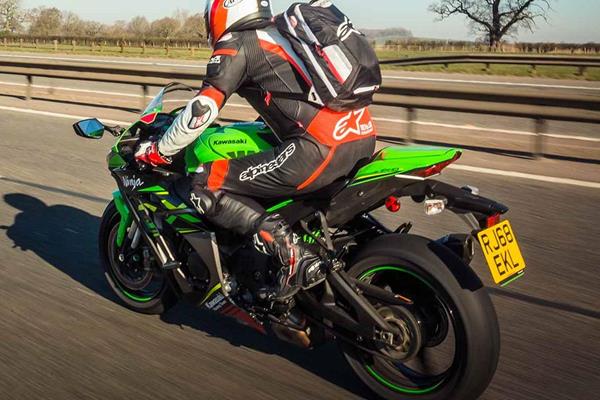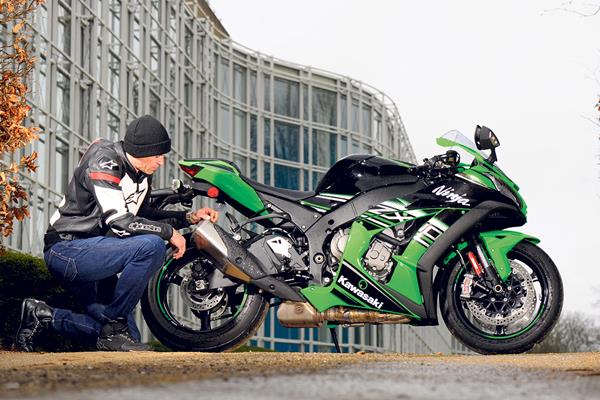KAWASAKI ZX-10R (2019 - 2021) Review

Highlights
- More of the same for ZX-10R fans
- Autoblipper now standard
- One of the cheapest superbikes around
At a glance
| Owners' reliability rating: | |
|---|---|
| Power: | 200 bhp |
| Seat height: | Medium (32.9 in / 835 mm) |
| Weight: | Medium (454 lbs / 206 kg) |
Prices
Overall rating
Next up: Ride & brakesKawasaki’s ZX-10R is an enigma. As a road bike it was a worthy rival to its Japanese counterparts, from its magnificent 2004 inception (forgetting the jelly mould 80s model), right the way until the BMW S1000RR came along in 2010. From that moment on, even with a major update in 2011 and a big tweak in 2016, it’s fallen ever further behind the competition.
- Latest news: 2021 Kawasaki ZX-10R and ZX-10RR revealed
- Related: Best superbikes
That 2016 ZX-10R was always smooth, stable, undoubtedly powerful and impressive when ridden in isolation, which explains its loyal fan base, but it quickly felt long in the tooth. The Kawasaki can’t match the BMW’s easy speed and practicality and doesn’t have the spine-tingling grunt of a crossplane Yamaha R1 or VVT Suzuki GSX-R1000. It also lacks the specialness of a Ducati Panigale and Aprilia RSV4, the grace of an old Honda Fireblade or the sharpness of the ’20 model. The ZX-10R’s brakes are also strangled by an overzealous ABS system that frustrates on a circuit and unless you’re a jockey-sized racer, it’s hugely cramped and uncomfortable.
For the casual observer that sounds hard to believe, especially when you look at the ZX-10R’s achievements on track. It’s won multiple WSB titles in the hands of Tom Sykes and Johnathan Rea, as well as success in all levels of racing. But of course, once you fit competition suspension, brakes, wheels, engine, swingarms, electronics and even frames with more or less flex (which they’re allowed to do in WSB), a racer is far removed from the humble road bike, especially with teams of clever engineers and talented racers to tweak it along the way.
![]()
With superbike sales so slow nowadays, Kawasaki are only interested in homologating enough ZX-10Rs to allow them to go racing, so none of the changes to the 2019 model address the road bike’s foibles. Instead, its minor updates are there to keep the race teams happy. The engine’s top end has a lighter valvetrain with new finger followers, an extra 3bhp and the RR version (the one they race) also has titanium rods and a 600rpm higher redline.
Away from racing these upgrades make little difference in the real world (although the stock ZX-10R now comes with the RR’s autoblipper), so it’s no surprise the ’19 bike feels the same as the 2016 model. MCN contributor Jon Urry rode it around the MCN250 test route and concluded: “If you are into circuit riding, the Kawasaki ZX-10R still delivers on its promise of being the most track-focused of all the Japanese inline four litre bikes. But on the road this single-minded nature results in a bike whose suspension is horribly harsh on uneven surfaces and whose motor is overly wild when you explore the upper end of its rev range and a bit gutless when you don’t.
But that just makes it a typical ZX-10R and some riders will love this focused and aggressive nature while others won’t. As always, it will split opinions.
Ride quality & brakes
Next up: EngineChassis-wise the 2019 ZX-10R is identical to the 2016 model, which in turn is a tweaked version of the 2011 bike.
Jon Urry says: "On a smooth road the Ninja’s track-focus makes it a joy, however throw in a few bumps and it all very quickly descends into a harsh ride that leaves you feeling decidedly battered and bruised with aching wrists.
"This is a bike that is far more at home on a track and if you try and take it on anything that doesn’t resemble the tarmac you would find BSB racers riding on you are going to suffer.
![]()
"That said, when you find that perfect stretch of road the Ninja comes alive and you can see why this chassis has won so many WSB titles. When it’s good it’s very, very, good. When it is bad it’s bloody horrible!"
Engine
Next up: ReliabilityNew cams, valves and a 20% lighter valvetrain sees finger-follower valve actuation for the first time, as found in the BMW’s S1000RR and the latest Suzuki GSX-R1000. It allows the engine to spin-up quicker and maintain high rpm more reliably. Power is up from a claimed 197bhp at the crank to 200bhp.
The RR version also has lighter titanium Pankl con rods, which saves 400g, reduces crank inertia by 5% and allows a 600rpm higher rev limit.
Urry says: "It is a motor that is very much two-stage in its power delivery, which will either appeal or frustrate. Below 8000rpm it is docile and remarkably civilised, which can either be viewed as relaxed or lacking in drive depending on your point of view.
"Get the revs up, however, and the Ninja switches character and goes completely insane and as the rev counter crosses the 8000rpm mark it even turns from orange to red as a warning.
![]()
"In this range the sheer ferocity of drive and instant punch takes your breath away as the Ninja delivers exactly the experience you would expect from something with 200bhp on tap.
"On the road this two-stage power delivery means you can easily ride it gently when you want and then dip into the power for a quick shot of adrenalin when the road ahead is clear.
"The new head makes virtually no difference to the way the power is delivered and will only be appreciated by racers, not road riders – especially as the new red cam cover, which signifies the updated head, is impossible to see behind the fairing!"
Reliability & build quality
Next up: ValueThis generation of motor and chassis can be traced back to 2011 and a quick glance of our owners’ reviews section for that and the 2016 model show nothing but glowing reviews for reliability and durability. The introduction of a new style of valve train is unlikely to change that and anyway, how many road riders will ever stress a 200bhp engine?
Value vs rivals
Next up: EquipmentThe Ninja is decent value when you consider what you are getting in terms of technology and track pedigree and it is the only one of the litre inline four Japanese sportsbikes that can genuinely boast race success on a world level.
![]()
But by the same token you are getting a bike that has remained visually fairly unaltered over the years. It’s lacking the latest and greatest brakes, 200 section rear tyres, electronics and gadgets. It doesn’t even have a TFT dash, Bluetooth connectivity or datalogging apps, which does make it seem a little behind the game.
But in terms of pure cash the standard ZX-10R is one of the cheapest superbikes you can buy. The best of the superbike class are all more expensive, including the Ducati Panigale V4 S, BMW S1000RR and Honda Fireblade.
Equipment
In terms of sportsbike technology, the Ninja has just about everything with three power modes, five-stage traction control (you have to be stationary to deactivate it), angle-sensitive ABS and traction control, launch control, anti-wheelie, engine brake control and 2019 sees an autoblipper function added to the quickshifter.
But, and this is a big but, the LCD dash is horribly dated when compared to the current crop of TFT displays and that really takes the shine off the Ninja. To gain semi-active suspension you need to invest nearly £5000 more for the SE model, which also comes with lightweight forged aluminium Marchesini wheels.
![]()
Specs |
|
| Engine size | 998cc |
|---|---|
| Engine type | Liquid-cooled, 16v, inline four |
| Frame type | Aluminium twin spar |
| Fuel capacity | 17 litres |
| Seat height | 835mm |
| Bike weight | 206kg |
| Front suspension | 43mm, Showa BFF forks, fully-adjustable |
| Rear suspension | Single Showa horizontal shock, fully adjustable |
| Front brake | 2x330mm discs with Brembo M50 four-piston radial calipers. ABS |
| Rear brake | 220mm single disc with single-piston caliper. ABS |
| Front tyre size | 120/70x17 |
| Rear tyre size | 190/55x17 |
Mpg, costs & insurance |
|
| Average fuel consumption | 36 mpg |
|---|---|
| Annual road tax | £121 |
| Annual service cost | - |
| New price | - |
| Used price | £10,500 - £12,400 |
| Insurance group |
17 of 17 How much to insure? |
| Warranty term | Two years |
Top speed & performance |
|
| Max power | 200 bhp |
|---|---|
| Max torque | 84.8 ft-lb |
| Top speed | 186 mph |
| 1/4 mile acceleration | - |
| Tank range | 135 miles |
Model history & versions
Model history
- 2004: The first of a new generation of ZX-10Rs is launched and it is typically ferocious and wild! Possibly a little too much…
- 2006: The Ninja is updated with a new, calmer, model that introduces twin underseat pipes, earning it the nickname ‘the wheelbarrow…’
- 2008: After riders reject the calmer model of Ninja, Kawasaki go back to the bike’s aggressive roots with a sharper generation that even features a (very basic) form of traction control. And no underseat pipes!
- 2011: A ground-up new Ninja is launched with a full electronics package and totally new chassis and 200bhp motor. It is the first of the Japanese sportsbikes to properly take the fight to the BMW S1000RR…
- 2013: An Öhlins electronic steering damper is added.
- 2016: The Ninja is heavily revised with more liner power, improved traction control, Showa BFF forks, cornering ABS and a quickshifter alongside chassis and styling tweaks.
- 2017: The homologation special ZX-10RR is launched and features a revised head with space for new high-lift cams and Marchesini wheels.
- 2018: The ZX-10R SE arrives with semi-active Showa suspension and Marchesini wheels.
- 2019: Updated ZX-10R has more power and a new valve train for more revs, aimed squarely at national and world superbike teams.
Other versions
- ZX-10RR: More track focussed and a limited run of 500. Engine features titanium con rods, a 600rpm higher rev-limit and one extra bhp more. Suspension settings are racier and it sits of lighter forged aluminium Marchesini wheels. Only available in lime green.
- ZX-10R SE: Based on standard model the SE has forged ali Marchesini wheels, semi-active suspension and ‘self-healing’ paint in areas prone to scuffing and high wear.
MCN Long term test reports

Long term update: Can I ‘Un-Euro 4’ the ZX-10R?
For 2017 new bikes will have to be Euro 4 compliant – cleaner and more efficient. It’s the reason so many manufacturers have compliant bikes this year and we’ll see even more rolled out at the bike shows this autumn. Euro 4 is the reason the new Ducati’s baby Panigale has spouted ugly pipes and why …
Owners' reviews for the KAWASAKI ZX-10R (2019 - 2021)
1 owner has reviewed their KAWASAKI ZX-10R (2019 - 2021) and rated it in a number of areas. Read what they have to say and what they like and dislike about the bike below.
Review your KAWASAKI ZX-10R (2019 - 2021)
Summary of owners' reviews |
|
| Overall rating: | |
|---|---|
| Ride quality & brakes: | |
| Engine: | |
| Reliability & build quality: | |
| Value vs rivals: | |
| Equipment: | |
Version: Performance
Year: 2020
Excellent sports bike for road or track








